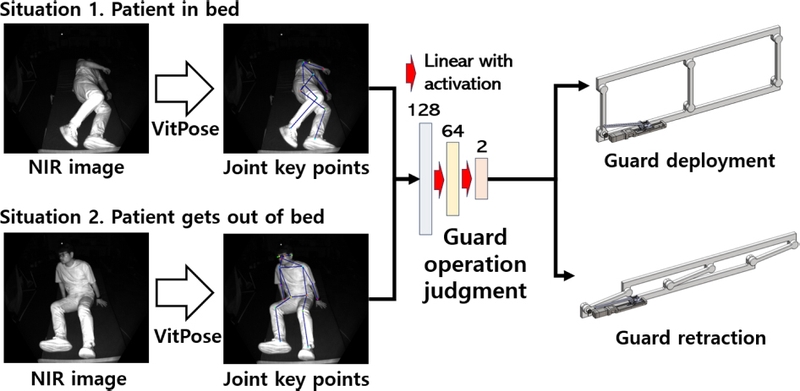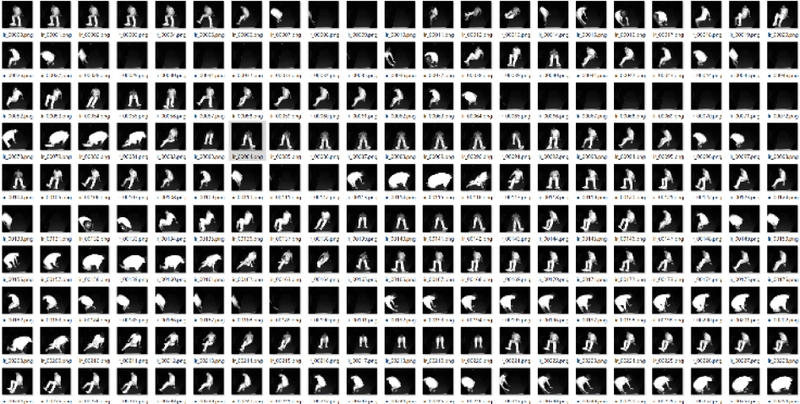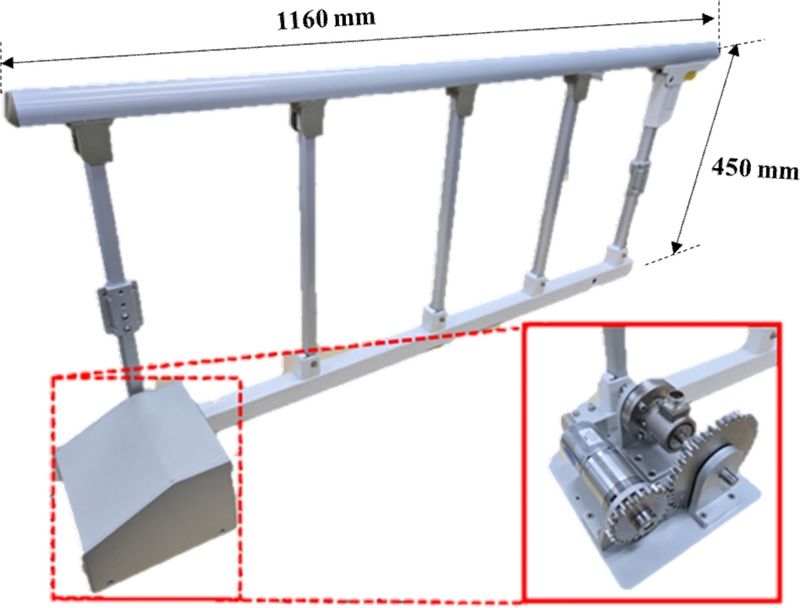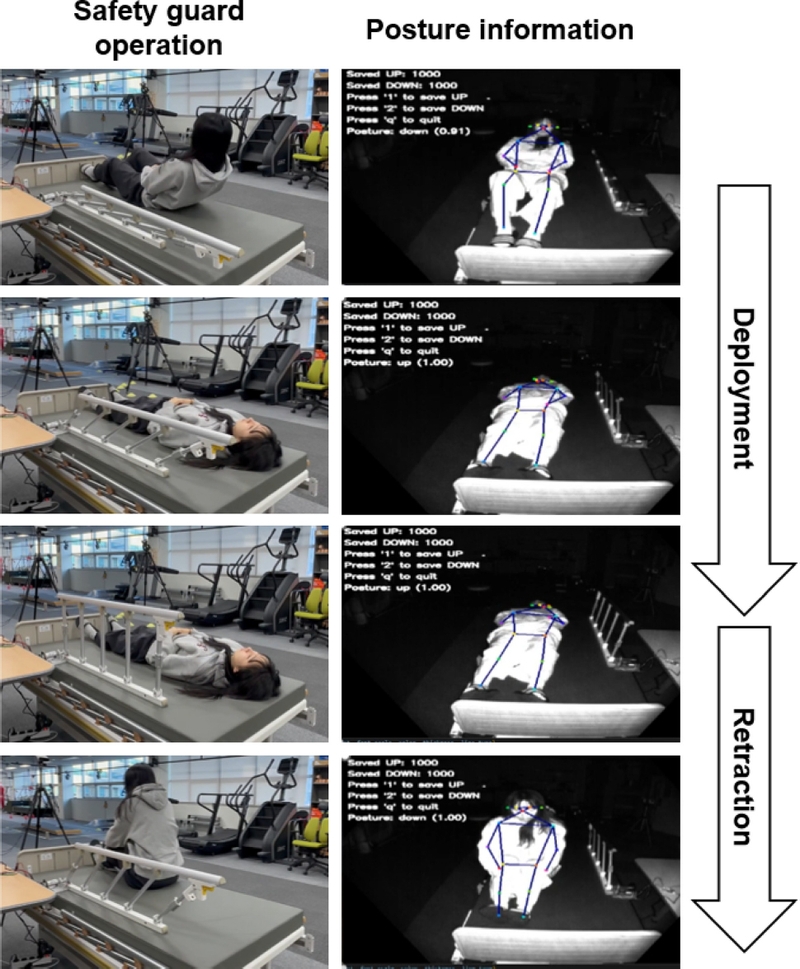
AI-Powered Bed Safety-Guard System for Fall Prevention in Elderly and Disabled Patients
This is an Open Access article distributed under the terms of the Creative Commons Attribution Non-Commercial License(https://creativecommons.org/licenses/by-nc/3.0/) which permits unrestricted non-commercial use, distribution, and reproduction in any medium, provided the original work is properly cited.
Abstract
The demand for innovative solutions for elderly and disabled patient care is becoming increasingly critical with the acceleration of global aging. This paper presents the development of an artificial intelligence (AI)-powered automatic bed safety-guard system designed to prevent accidental falls among bedridden patients. The system integrates an infrared camera-based real-time posture-estimation algorithm with an intelligent safety-guard control mechanism that determines deployment and retraction based on patient movements. The motorized safety guard, driven by a brushless DC (BLDC) motor, precisely aligns with the position of the patient to ensure smooth and reliable operation. Performance evaluations demonstrated 98% accuracy in posture-based safetyguard operation. The motorized guard operated at speeds of up to 72.5°/s with high linearity (R2 < 0.996), ensuring precise and stable movement. The experimental results confirm its effectiveness in enhancing safety and usability in long-term care, paving the way for AI-driven advancements in geriatric healthcare and smart assistive systems.
Keywords:
Artificial intelligence-powered bed safety guard, Posture recognition system, Motorized safety mechanism, Smart healthcare1. INTRODUCTION
The global aging trend highlights the growing need for innovative technologies for elderly and disabled care. By 2050, over 40% of South Korea’s population is expected to be aged 65 or older, placing significant strain on healthcare systems and caregivers [1,2]. As caregiving demands and costs continue to increase, the need for smart-bed systems and assistive solutions has become increasingly urgent. Among these challenges, falls remain a critical risk factor for bedridden patients, often leading to fractures and long-term disability, particularly in older adults [3].
Previous studies on bed falls have primarily focused on detection-based systems [3,4], which analyze fall patterns and enable prompt medical intervention, but do not actively prevent falls. Some studies have proposed manual fall prevention methods based on pattern analysis [5]; however, these have limited effectiveness and fail to reduce caregiver burden. Moreover, traditional manual bed-safety guards lack adaptability to meet the diverse needs of patients, thereby increasing caregiver dependency. Recent advances in artificial intelligence (AI)-driven healthcare and fall prevention systems [6-9] underscore the growing need for intelligent assistive technologies. Automated safety guards offer real-time adaptability, enhancing both patient safety and caregiver efficiency.
Our proposed system builds on these advancements by integrating real-time posture estimation with a motorized safety guard, improving fall prevention and reducing caregiver workload. The system utilizes a posture recognition algorithm and brushless DC (BLDC) motor-driven safety guard to ensure smooth and reliable operation. The proposed system aims to provide a robust, efficient, and user-friendly solution that meets the growing demands of modern healthcare and geriatric care technologies while enhancing patient safety and reducing caregiver burden.
2. MATERIALS AND METHODS
2.1 Design of a Safety-Guard System
In Fig. 1, the safety-guard system comprises three main components: a camera sensor, an AI software framework, and a motorized safety-guard mechanism.
A near-infrared (NIR) camera (Azure Kinect, Microsoft, USA) was used to capture the real-time posture of bedridden patients. Unlike standard RGB images, NIR images maintain clarity even under low-light conditions (Fig. 2 (a)), making them ideal for continuous nighttime monitoring. NIR images were used to infer the posture information of patients. Based on this information, the operation of the safety guard was determined.

NIR-based posture estimation: (a) NIR and RGB images under low-light conditions. (b) Posture estimation with various camera placements and patient poses.
To determine the optimal camera placement for robust patient posture estimation on the bed, various positions of the NIR camera (foot, head, and left and right sides of the bed) were tested, as shown in Fig. 2 (b). Multiple patient postures, including lying in the supine position, on one side, and either fully or partially covered by a blanket, were also tested. To reduce the effects of varying illumination conditions, the captured NIR images were normalized based on their maximum and minimum intensity values. Placing the camera at the foot side of the bed, approximately 30 cm above the mattress and angled diagonally downward, provided the most reliable capture of posture information.
The AI software framework integrated patient posture estimation with a safety-guard operation judgment network. Vit-Pose [10], a state-of-the-art network in this field, was utilized for real-time patient posture estimation. VitPose infers joint keypoints, such as the ankle, knee, shoulder, and wrist of the patient from the input image. The relationship among these joint keypoints is defined as the posture information.
Three linear layers with activation functions were stacked to determine the operation of the safety guard. The pixel positions of each joint keypoint in the NIR image were used as network inputs. The output of this network classified the state into two categories: guard deployment and retraction. When the patient is in bed, the safety guard is deployed to prevent falls; when the patient attempts to exit the bed, the safety guard retracts to allow movement (Fig. 3).
The motorized safety-guard mechanism consists of a safety bar and an actuation module, as shown in Fig. 4. The actuation module is powered by a BLDC (PH36-BL3640, Motorbank, Republic of Korea) to ensure smooth and precise movements during deployment and retraction. By integrating a torque sensor (TCN16-10KC, DACELL, Republic of Korea) into the gear of the actuation module, a safety function was implemented to minimize potential pinch injuries during the operation of the safety guard.
2.2 Data Collection and Model Training
For VitPose, pretrained weights were used without further fine-tuning. To train the safety-guard operation judgment network, posture information data were collected using 640 × 640 NIR images, as shown in Fig. 5. The participants simulated a variety of postures common in bedridden scenarios, such as lying down, sitting, and transitioning between these states. A total of 2,000 images were collected. The resulting data were labeled by experts as requiring either bed safety-guard deployment or retraction.
Before training, the joint keypoint values were normalized to [0,1] by dividing them by 640, which was the image dimension for both the x and y axes. In addition, the training and validation datasets were split into an 80:20 ratio. During training, the Adam optimizer was used with a learning rate of 0.001, and the batch size was set to 32. After 25 epochs, the entire training process took less than 1 min, resulting in a validation accuracy of 98% using the rectified linear unit (ReLU) activation function. Using sigmoid and Leaky ReLU activation functions under the same training conditions resulted in validation accuracies of approximately 98% and 99%, respectively.
2.3 System Integration and Prototyping
A unified software program was developed to control the safety-guard operation based on classified posture states. The system automatically retracts the safety guard when the patient attempts to get out of bed and deploys it once the patient is safely positioned on the bed to prevent falls. For prototyping, a motorized actuation module was integrated into commercial safety guards with dimensions of 1160(L) mm × 450(H) mm. This approach leveraged standard safety-guard dimensions, streamlined the prototyping process, and ensured compatibility with conventional designs.
The system operates intermittently, with the motor consuming approximately 15 W at peak power and 1.2 W in the standby mode during deployment and retraction. Because these actions occurred infrequently, overall power consumption remains low. Future optimizations can include implementing a low-power mode in the motor control system when no posture changes are detected, further reducing energy usage in hospitals and caregiving environments.
3. RESULTS AND DISCUSSIONS
3.1 Posture Estimation Performance
The performance of the AI software framework was tested in a setting that simulated real-world conditions. In Fig. 7, a participant performed arbitrary continuous movements for over 1 min, during which the proposed system inferred the posture information and determined the operation of the safety guard. The proposed AI-powered safety-guard system responded to patient movements in real time at over 30 fps. Throughout the experiment, there were no instances in which the safety-guard system operated in a manner contrary to its intended design.
3.2 Safety-Guard Mechanism Evaluation
The motorized safety guard was evaluated to ensure smooth and precise movement during deployment and retraction. To measure its performance, an encoder (AS5147, ams OSRAM, Austria) was attached to the motor shaft to track the rotation of the guard in real time. The movement was controlled using a proportional-integral-derivative (PID) control algorithm (Kp = 10, Ki = 0.01, Kd = 0.01), which continuously adjusted the motor speed based on the encoder feedback [11]. This allowed the system to maintain a defined target speed. In Fig. 8, the system demonstrated smooth operation at speeds of up to 72.5°/s while maintaining a high linearity (R² > 0.996) across all tested speed ranges, ensuring precise and reliable performance. These results demonstrate that the PID-controlled safety guard moves smoothly, adapting dynamically to ensure stable and accurate operation. Such precise control is crucial for patient safety, ensuring seamless deployment and retraction without unexpected delays or irregularities.
3.3 Optimization of Safety-Guard Height
The optimal guard height was determined to be 220–260 mm above the mattress surface based on the center of mass (CoM) analysis of the user, as shown in Fig. 9. The CoM data were collected using a VICON motion capture system (VICON, UK), which tracked movement paths for various postures, including sitting, lying on the side, and twisting [12]. The analysis indicated that the optimal safety-guard height should be approximately 1.5–2.0 times the CoM height, ensuring effective fall prevention during lateral and transitional movements.
3.4 Limitation and Future Directions
Although the system demonstrated robust functionality and reliability, further refinements are required to enhance its adaptability across diverse patient conditions. One key area for improvement is expanding its ability to accommodate a broader range of patient postures and movement patterns. In addition, expanding the dataset used for training the AI model is essential to improve the accuracy of the system in recognizing less common or more complex scenarios. Further advancements in AI modeling, such as incorporating advanced network architectures and specialized training strategies, will enhance the ability of the system to handle a wider range of patient behaviors more effectively. Finally, although the proposed system is primarily intended for controlled indoor environments, incorporating adaptive thresholding and exposure-control techniques may be necessary to mitigate the potential impact of direct sunlight interference under unexpected lighting conditions. Personalized fine-tuning strategies using user-specific data, such as individual posture patterns or personalized joint keypoint relationships, can be introduced in future studies to enhance the robustness and adaptability of the model to diverse patient conditions. These enhancements will ultimately improve scalability and clinical applicability, making the system more adaptable to various patient demographics and healthcare environments.
4. CONCLUSIONS
This study successfully developed and validated an AI-powered bed safety-guard system that integrated real-time patient posture estimation with automated guard deployment and retraction. The system achieved high accuracy (98%) in posture recognition and demonstrated precise motion control, operating at speeds of up to 72.5°/s with a high linearity of R² > 0.996 across the entire speed range. By automating the operation of the safety guard, the proposed system enhances patient safety while reducing caregiver burden, offering a practical solution for elderly and disabled care. In addition, the motion capture-based CoM analysis verified the ability of the system to optimize the guard height, ensuring effective fall prevention across various patient postures. Future work will focus on expanding the dataset to improve AI model adaptability, enhancing system robustness for a broader range of patient behaviors, and conducting real-world clinical validations to assess long-term usability and effectiveness. These advancements will contribute to the widespread integration of AI-driven assistive technologies into smart healthcare systems, fostering safer and more efficient elderly care solutions.
Acknowledgments
The research was supported by the NK254H and NK257D projects of the Korea Institute of Machinery and Materials (KIMM).
References
- H.-C. Lee, Population Aging and Korean Society, Korea J. 61 (2021) 5–20.
-
N. Kim, Long-term care services expenditure projection in South Korea from 2015 to 2050, Int. J. Health Plann. Manage. 30 (2013) 45–56.
[https://doi.org/10.1002/hpm.2204]

-
F. Hussain, M. Ehatisham-ul-Haq, M. A. Azam, A. Khalid, Elderly Assistance Using Wearable Sensors by Detecting Fall and Recognizing Fall Patterns, Proceedings of the 2018 ACM International Joint Conference and 2018 International Symposium on Pervasive and Ubiquitous Computing and Wearable Computers, Singapore, 2018, pp. 770–777.
[https://doi.org/10.1145/3267305.3274129]

-
J. Shim, M.-H. Shim, Y.-S. Baek, T.-D. Han, The development of a detection system for seniors' accidental fall from bed using cameras, Proceedings of the 5th International Conference on Ubiquitous Information Management and Communication, Seoul, Korea, 2011, pp. 1–4.
[https://doi.org/10.1145/1968613.1968734]

-
T.-H. Tung, M.-C. Liu, J.-Y. Yang, W.-Y. Syu, H.-P. Wu, Useful methods in preventing accidental falls from the bed in children at the emergency department, Eur. J. Pediatr. 168 (2009) 1323–1326.
[https://doi.org/10.1007/s00431-009-0928-x]

-
D. Mohan, D.Z. Al-Hamid, P.H.J. Chong, K.L.K. Sudheera, J. Gutierrez, H.C.B. Chan, Artifical Intelligence and IoT in Elderly Fall Prevention: A Review, IEEE Sens. J. 24 (2024) 4181–4198.
[https://doi.org/10.1109/JSEN.2023.3344605]

-
L. Chen, C. Xia, Z. Zhao, H. Fu, Y. Chen, AI-Driven Sensing Technology: Review, Sensors, 24 (2024) 2958.
[https://doi.org/10.3390/s24102958]

-
M. Um, M. Kang, K. Eom, H. Kwak, K. Noh, J. Lee, et al., A Multi-bit ECRAM-Based Analog Neuromorphic System with High-Precision Current Readout Achieving 97.3% Inference Accuracy, IEEE Trans. Biomed. Circuits Syst. (2024) 1–14.
[https://doi.org/10.1109/TBCAS.2024.3465610]

-
Y. Ko, S. Kim, K. Shin, Y. Park, S. Kim, D. Jeon, A 65nm 12.92nJ/inference Mixed-Signal Neuromorphic Processor for Image Classification, IEEE Trans. Circuits Syst. II Express Briefs 70 (2023) 2804–2808.
[https://doi.org/10.1109/TCSII.2023.3252501]

- Y. Xu, J. Zhang, Q. Zhang, D. Tao, ViTPose++: Vision Transformer for Generic Body Pose Estimation, arXiv, https://arxiv.org/html/2212.04246v3, (2022)
-
M.A.Johnson, M.H. Moradi, PID Control, Springer, London, 2005.
[https://doi.org/10.1007/1-84628-148-2]

-
T. Ryo, K. Takuya, Y. Takahiro, Validity of the total body centre of gravity during gait using a markerless motion capture system, J. Med. Eng. Technol. 42 (2018) 175–181.
[https://doi.org/10.1080/03091902.2018.1449909]









